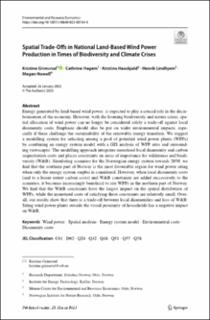Spatial Trade-Offs in National Land-Based Wind Power Production in Times of Biodiversity and Climate Crises
Peer reviewed, Journal article
Published version
Permanent lenke
https://hdl.handle.net/11250/3062784Utgivelsesdato
2023Metadata
Vis full innførselSamlinger
- Artikler / Journal articles [426]
- Publikasjoner fra Cristin [138]
Originalversjon
10.1007/s10640-023-00764-8Sammendrag
Energy generated by land-based wind power is expected to play a crucial role in the decarbonisation of the economy. However, with the looming biodiversity and nature crises, spatial allocation of wind power can no longer be considered solely a trade-off against local disamenity costs. Emphasis should also be put on wider environmental impacts, especially if these challenge the sustainability of the renewable energy transition. We suggest a modelling system for selecting among a pool of potential wind power plants (WPPs) by combining an energy system model with a GIS analysis of WPP sites and surrounding viewscapes. The modelling approach integrates monetised local disamenity and carbon sequestration costs and places constraints on areas of importance for wilderness and biodiversity (W&B). Simulating scenarios for the Norwegian energy system towards 2050, we find that the southern part of Norway is the most favourable region for wind power siting when only the energy system surplus is considered. However, when local disamenity costs (and to a lesser extent carbon costs) and W&B constraints are added successively to the scenarios, it becomes increasingly beneficial to site WPPs in the northern part of Norway. We find that the W&B constraints have the largest impact on the spatial distribution of WPPs, while the monetised costs of satisfying these constraints are relatively small. Overall, our results show that there is a trade-off between local disamenities and loss of W&B. Siting wind power plants outside the visual proximity of households has a negative impact on W&B Spatial Trade-Offs in National Land-Based Wind Power Production in Times of Biodiversity and Climate Crises
